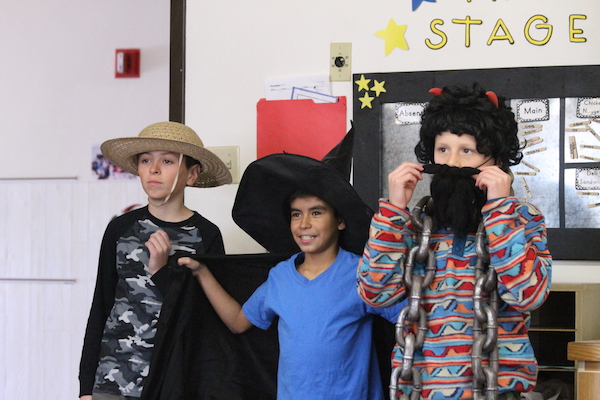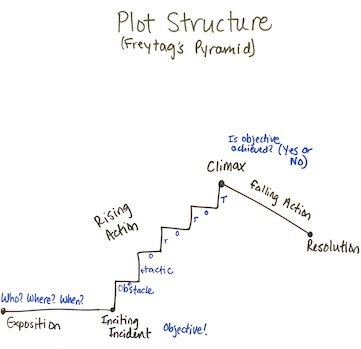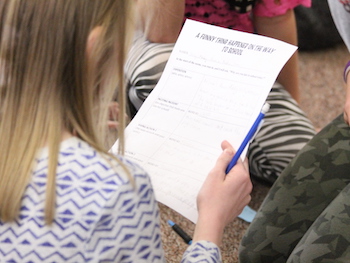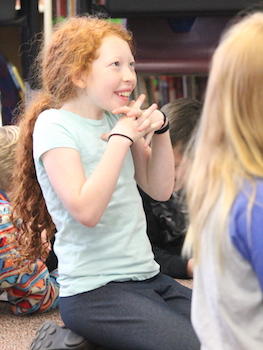SUBJECTS
GRADE
Show Results
A Funny Thing Happened on the Way to School

Lesson Summary
- Write and perform an original story using elements of a story arc.
- Incorporate words and phrases assigned from other classmates.
Lesson Plan and Procedure
Lesson Key Facts
- Grade(s): 4, 5, 6
- Subject(s): Drama, English Language Arts
- Duration of lesson: 55 minutes
- Author(s): Haley Flanders
Warm-Up/Hook
Teacher: I am going to play an instrumental track and pause it every 20 seconds, giving you a description of a setting, emotion, or character. You'll then move in a way that depicts that description when the music returns.
Have the students start off walking normally. Then play the music, pause, describe, and repeat. Some sample descriptions are hot desert, stormy ocean, arctic tundra, a crazy bird, a clumsy elephant, and so on.
Reflection
Teacher: What was easy or hard about the warm-up? During the warm-up, you were given descriptions, but you got to decide how to interpret those descriptions. Today, we are going to write a story that includes words or phrases assigned by your classmates, but you will decide how to incorporate their phrases into a plot.
This will teach students to respond positively to others’ ideas.
Teacher: You will be placed in groups of four to five and will be writing and performing your story for the class with this writing prompt: a funny thing happened on the way to school.
Introduction

Give a brief lesson on story arcs. Explain how stories are typically structured, and that their story will mirror this arc. Draw or use a chart that shows the following points on the arc:
- Exposition: the introduction to characters (who) and setting (when and where the story takes place)
- Inciting Incident: the moment in the story when the character’s goal emerges
- Rising Action: all the obstacles and events that take place as the character tries to achieve his or her goal
- Climax: the highest point of tension in the story when audiences are waiting to see if the goal is achieved
- Falling Action: all of the events that take place after the objective has (or has not) been achieved, wrapping up the story
Instruction/Rehearsal
Teacher: Your story is going to explain why your group was late to school.

Show them the script template and read its sections.
Hand each student two strips of paper. On one, have them write a random word. On the other, have them write a random phrase or sentence. Collect these and mix them up, keeping the words and phrases separate.
Split the class into groups of four or five students. Hand each group three “word” papers and one “phrase” paper. (You will probably have extras.) The group will decide which word goes on the template. Invite the students to fill out the template. Have them write their story in the blank boxes corresponding to the story element. Encourage one to two sentences per box and remind them that the assigned words on the strips must show up somewhere in the box.
The phrase is featured in the last box. The story ends with this sentence: “And that is why we were late to school.” (Having uniform ending lines helps everyone know the story is over and gives it a strong ending.)
Give the students time to write and rehearse how they will act out and narrate their story. They can use props that are already in the classroom.
Activity/Performance

Have the class come together and take turns performing. It is best to number the groups on their sheet so that the order is already decided.
Conclusion
Teacher: What was fun about this assignment? What was difficult? What did you learn about the importance of words in a story and using other people’s ideas? What did your learn about story structure? Why is it important to have a strong structure to your story? What might happen if you wrote a story with a completely different structure, such as having the elements in a different order?
Learning Objectives
- Establish a situation and characters who respond to actions.
- Use descriptions and concrete words.
- Provide a conclusion.
- Develop personal imagination.
- Write a script that focuses on the five w’s: who, what, where, when, and why.
- Define roles and work in a group.
- Communicate character and story through physical movement.
- Demonstrate audience skills.
Utah State Board of Education Standards
This lesson can be used to meet standards in many grades and subject areas. We will highlight one grade’s standards to give an example of application.
Grade 4 English Language Arts
- Standard 4.W.3: Write narrative pieces to develop real or imagined experiences or events using effective technique, descriptive details, clear event sequences, and provide a resolution.
- Orient the reader by establishing a situation and introducing a narrator and/or characters; organize an event sequence that unfolds naturally.
- Use dialogue and description to develop experiences and events or show the responses of characters to situations.
- Use a variety of transitional words and phrases to manage the sequence of events.
- Use concrete words, phrases, complex sentences, and sensory details to convey experiences and events precisely.
Grade 4 Drama
- Standard 4.T.CR.1: Develop imagination to create artistic ideas and work.
- Standard 4.T.CR.3: Write or record simple dramas that include the five W's of who, what, where, when, and why.
- Standard 4.T.CR.4: Define roles, identify responsibilities, and participate in group decision-making.
- Standard 4.T.CR.5: Create character through imagination, physical movement, gesture, sound, speech, and facial expression.
- Standard 4.T.CR.7: Recognize that participating in the rehearsal process is necessary to refine and revise.
- Standard 4.T.P.3: Observe, listen, and respond in character to other actors throughout a scripted or improvised scene.
- Standard 4.T.P.4: Communicate meaning using the body through space, shape, energy, and gesture.
- Standard 4.T.R.1: Demonstrate audience skills of observing attentively and responding appropriately.
Equipment and Materials Needed
- An instrumental track
- Small strips of paper
- A Funny Thing Happened on the Way to School Today template
Additional Resources
- Sample music for the warm-up, “Happy Classroom Music - Fun Music for the Classrooms Instrumental”
- To help your students come up with phrases for their stories, visit this site, which has funny quotes by children
- For more information on Freytag’s pyramid, visit this site
- Or show your class the following slides on Freytag’s pyramid
- As a follow-up or warm-up activity, read A Funny Thing Happened on the Way to School (2015) by Benjamin Chaud and Davide Calì
Image References
Images 1–4: James Huston.

www.education.byu.edu/arts/lessons
 Download
Download